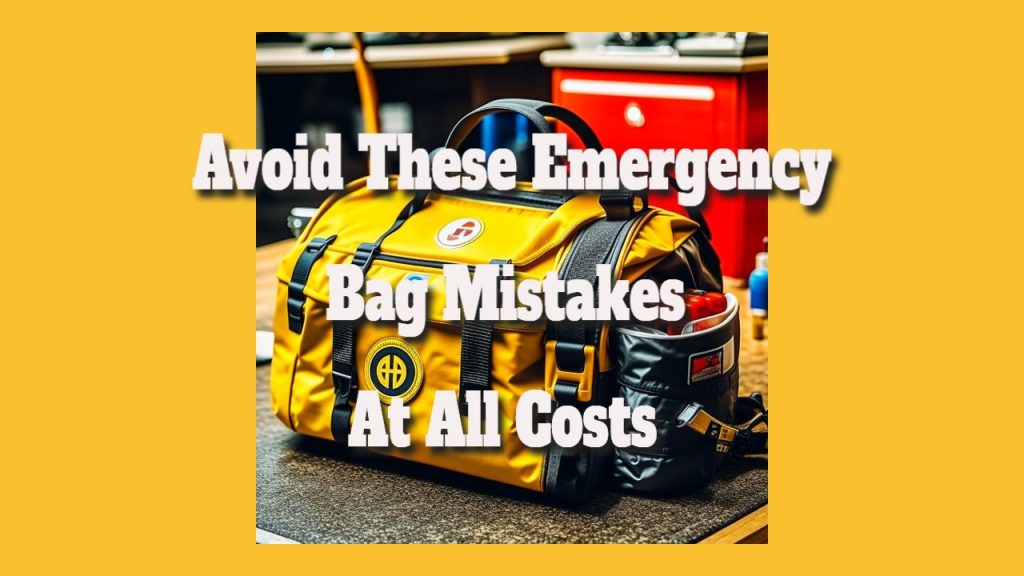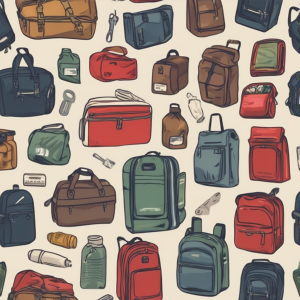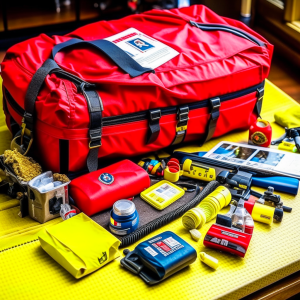Avoid These Emergency Bag Mistakes At All Costs
Avoid These Emergency Bag Mistakes At All Costs
Avoid These Emergency Bag Mistakes At All Costs: The emergency bag is a portable kit containing everything a person needs to survive for at least 72 hours.
It is a collection of stuff designed to keep you alive if you bug out.
Most preppers make the mistake of getting too caught up in their escape plan and needing to spend more time developing the fundamentals of their emergency kit.
The “escape bag basics” involve learning essential skills for an escape, such as constructing a survival fire and understanding what goods to pack in an escape scenario.
Although the ultimate purpose of an emergency bag is to assure your survival, don’t overpack it to the point where it weighs as much as a rock.
Before we look at the shortcomings of an emergency bag, consider the purpose of an emergency backpack.

Why Do You Need An Emergency Kit?
Generally, a bug-out bag is a survival gear that keeps you alive in an emergency for at least 72 hours.
A solid emergency kit will save you time when seconds count in critical situations. You can take your packed backpack and depart instantly if your emergency bag is ready.
This allows you to focus all of your time, energy, and concentration on getting to safety.
The Most Common Blunders With An Escape Bag
Now that we know why you should carry an emergency bag let’s take a look at how people make blunders that involve
Choosing the incorrect emergency bag
Spending less money while getting the most out of things is preferable. However, investing reasonable money and TIME in safety is unquestionably worthwhile.
Your bag may be overly hefty, have little space for your requirements, or appear improper overall.
Purchasing an insufficient bag reduces your chances of surviving in an emergency event. I recommend reading this post to determine which bag suits your needs. After reading about each bag, you may determine which best suits your needs by weighing the design, construction material, and price.
Weight of a Bug Out Bag
The bug-out bag should be tailored to your specific needs. It should not be very hefty. As a general guideline, the bag should carry at most 25% of your body weight.
Here are some pointers to help you avoid making a bag you can’t carry.
Limit yourself to the necessities.
The essential items in the event of an escape are sometimes summarised as the five musts of the Survivability rule:
- Knife (cutting)
- (Fire) is burning.
- Paracord (cordage)
- Water/filter container
- shelter (protection)
I will elaborate on each of these topics later in this piece.
Clothing for extreme weather
If you reside where dangerous storms can occur, prepare for extreme weather conditions. Pack adequate clothing and shelter for the weather conditions you may encounter.
Consider how much you can transport.
Determine whether the emergency bag is intended to last 24 hours, 48 hours, or 72 hours. A 72-hour emergency bag should have a capacity of 40 litres or 2,500 cubic inches for an adult.
Remember to be adaptable as well. If you’re hiking with your family, you can split the burden and bring fewer supplies (or more if you’re physically fit).
Only Purchase A Rucksack After Thoroughly Testing It.
Although reviews can help you find the best rucksack, I recommend you test it thoroughly before purchasing it.
You can try them on at a local sports store.
Put weights on the rucksack and walk around with it for a time to put it through its paces. You can request some bean bags from the seller to mimic a breakout situation.
You’ll discover if the bag is good if you wear it long enough.
Buying a bag that doesn’t draw attention to itself
When hiking, you should appear to need more preparation and equipment. It is preferable to blend in with the crowd and wear what most people would wear (at least on the surface).
Buying a bright-colour purse makes you more likely to attract unwanted attention.
You can want your rucksack to appear tactical or concealed.
Some of your preferences can be accommodated, but your bag must integrate nicely with your surroundings. Some bags can appear cool in some settings but improper in others.
Packing superfluous gear and goods is mistake number three.
This entails getting rid of unneeded gear and being more agile.
The Survivability Rule’s 5 C’s
When packing your emergency kit, remember the 5 C’s: cutting, combustion, cordage, container, and cover.
Knife (cutting)
A knife is helpful for both self-defence and tactical purposes. Lighting a survival fire or digging a pit are examples of tactical reasons.
If you have a small amount of room, you can store multiple, including a saw, scissors, and knife, in a single device.
Fire (combustion)
I would bring portable stoves and lighters with you. Portable stoves allow you to prepare food and boil water for consumption. To increase combustion, utilise gas lighters or ferro rods with lighters.
Paracord (rope)
I recommend purchasing 550 paracords because it is the most useful. You may use paracord in various ways, like building a paracord hammock or pitching a tent.
Water/filter container
You must bring a container to hold clean drinking water or food. A portable water filter is helpful in addition to food and water that may be consumed immediately.
Shelter (protection)
Shelter is an essential piece of gear. You must be prepared to protect yourself from severe weather conditions. Appropriate clothes are also required. Plan for three layers of clothing: exterior, middle, and inner.
Your rucksack should be at most one-third of your total body weight. This tip is essential because many people prefer to overpack—another reason to plan the contents of your rucksack and avoid needless goods.
Carrying a heavy rucksack is also harmful to your back. Imagine carrying a 40-pound backpack for several miles, which would be uncomfortable.
Consider carefully what goods you wish to bring in your luggage. Always ask yourself if this item is genuinely vital for survival.
Packing too little food or water is mistake number four.
Packing too little food or water is a catastrophic mistake, mainly if your area has limited food and water supplies.
Water
It is standard practice for every prepper to bring at least one gallon of water daily for one adult. A gallon daily is required unless you are sure there will be water sources on the route to your getaway site.
Other suggestions include collapsible water bottles for more storage space. Consider installing a suitable water purification system to filter the water as needed.
Food
A daily calorie intake of 3500 is advised for an average-sized adult who exercises moderately.
Your diet should give you enough energy to keep your body running. I propose energy bars or backpack meals because they offer more calories.
Forgetting To Keep Essential Documents
These documents should also be brought with you when you emigrate.
I felt it would be helpful to list the essential documents you should bring:
Personal documents (a) Passports (b) House and apartment insurance policies (c) Vehicle (or motorbike) licence (d) Insurance policy (e) Driver’s licence (f) (g) Identification card Credit card duplicates (h) List of critical phone numbers (i) Medical insurance card
Original will (a) Revocable trust deed (b) Proof of land ownership (or property title) (c)
Identity documents are required for government officials to prove your citizenship. They assist them in determining whether to grant you protection.
The health card is essential if you intend to seek medical attention shortly after departing. The doctor can study your medical history and recommend appropriate medicine and treatment.
Inadequate Practical Training
There’s an adage that says, “Practice makes perfect.” There’s no doubt that a successful escape necessitates various abilities, including the ability to light a survival fire, construct a proper survival shelter, and even know how to filter water.
It would not be very sensible to stuff your luggage with tools you don’t know how to utilise.
The items will only be helpful if you know how to use them correctly.
Make practical training enjoyable so that it does not feel like a chore. You may schedule a weekly camping trip to the woods with your family. Your youngsters will acquire the skills much faster if they enjoy it.
Remember that these drills aim to familiarise yourself with the tools in your emergency kit. Your chances of survival increase considerably if you can use the equipment effectively.
Failure To Pack Emergency Bag Repair Supplies
Most people discovered later that their emergency kit was weaker than they thought.
Most people believe they must carry their bag for 72 hours before returning home.
However, the bag must endure continual pressure for at least three days, preferably much longer.
To address this issue, you should bring a sewing kit with you so that you may fix your bag if necessary.
While a quick sewing awl would be helpful, a needle and some thread would suffice.
Even if your bag is heavy-duty, I recommend packing a sewing kit. During a getaway, you will be compelled to overcome various barriers, which may necessitate the repair of your bag or something else.
This is critical since you will require a large bag to hold all your goods. If you’ve packed everything you’ll need, you don’t want to abandon them just because you can’t carry them.
Another suggestion is to safeguard your rucksack adequately. Because your rucksack includes all your belongings, it only makes sense to protect it carefully.
You may even continually inspect the seams, the inner shell of the backpack, and whether or not water has entered the backpack.
There Was No First-Aid Kit Or Medical Supplies.
If you don’t have running water or power, chances are you don’t have good hygiene or health. You are more likely to come into contact with viruses and germs if you expose your body to outside filth.
I strongly advise you to prepare for hygiene-related ailments like vomiting or diarrhoea. I also suggest carrying something for mobility issues.
You must arrange the necessary first aid and medication to deal with this issue.
Tourniquets, roller bandages, and antibiotic wound ointment are all crucial first-aid products to have on hand. Antiseptic wipes are essential for removing microorganisms from an injury.
Ibuprofen, aspirin, Immodium, throat lozenges, bismuth tablets, and cranberry extract are among over-the-counter drugs to consider.
These errors occur primarily because more thought should be given to what a bug-out situation may entail.
This involves knowing which object to use in which situation, how to utilise it, and how each item can assist you in travelling from point A to point B.
Any prepper can assemble an emergency kit, but what distinguishes the men from the boys is how much care and thinking goes into it. Everything you bring in your backpack should be considered rather than obsessive.





